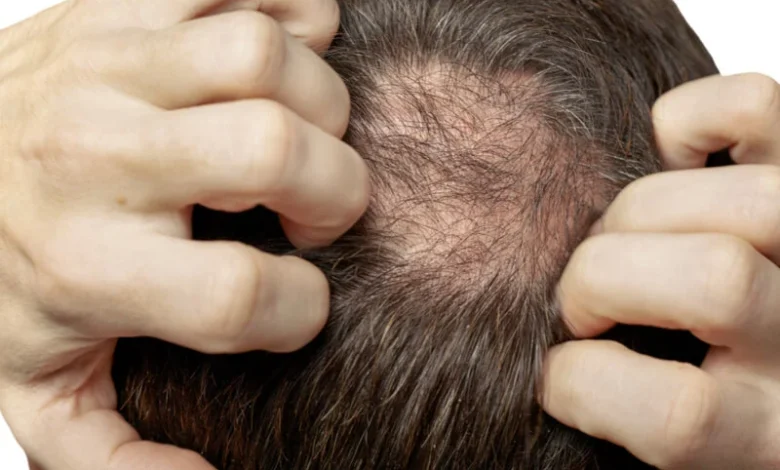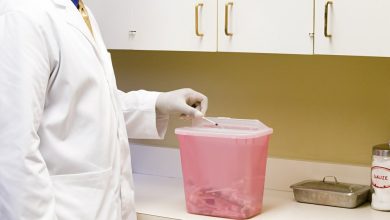How to Treat Male Pattern Hair Loss?

Male pattern baldness affects roughly half of all men over 30. This disorder is often caused by a genetic flaw that stops hair follicles from making new hair, leaving behind only thin vellus hairs. Every day, millions of men start to detect the early signs of male pattern baldness. In fact, 16% of men aged 18 to 29 already experience moderate to severe hair loss.
About half of the adult male populations in North America, Europe, Africa, Australia, and New Zealand are affected by Male Pattern Baldness (MPB). Because it appears to be inherited from one or both parents, it is also known as “hereditary alopecia areata.” Genetics appear to play a role in more than 80% of cases. While MPB is not life-threatening, its repercussions can be disastrous.
Patchy regions of lost hair on the crown, temples, and/or top of the head are the most typical signs. These patches may enlarge over time and keep growing until they almost entirely cover the skin; at this point, surgery is typically required to treat severe instances. If left untreated, this hair loss can make those who experience it depressed and anxious.
Before continuing, it’s important to note that numerous conditions can cause hair loss. Some of them share symptoms, but they differ significantly from one another.
Table of Contents
What Could Have Caused Male-Pattern Hair Loss?
For example, telogen effluvium, a temporary hair loss, can be caused when a woman’s body sends out too many hormones during her monthly cycle. Her hair will begin to fall out if she doesn’t get relief soon enough.
But if the problem continues, the hormone imbalance could affect her ovaries, uterus, and fallopian tubes. Men with telogen effluvium often have patches of thin, brittle hair in unexpected places.
However, these issues only last for a short time. Another illustration would be follicular atrophy, which causes hair clumps to grow around your eyelashes and eyebrows. While this typically occurs after years of using depigmenting creams, other treatments, like chemotherapy drugs, can also cause it.
Don’t worry if you’ve noticed bald spots on your scalp or other body parts. Those bald spots could be developing for several reasons, including the ones listed below:
Do you Know Much about Your Genes?
According to some studies, heredity is to blame for roughly 90% of cases of hereditary hair loss. As a result, if either of your parents has MPB, there is a high likelihood that you will develop it in the future.
Nutrition-Deficiency Hair loss can be caused by a deficiency in folic acid, iron, or vitamin B12. So that your general health remains robust, make sure you consume many foods high in essential nutrients daily.
What Are the Environmental Causes?
You can also lose your hair if you live in temperatures below 32 degrees Fahrenheit (-0.01 C), above 95 degrees Fahrenheit (+35 C), or if you do a lot of physical work without getting enough rest and sleep.
Medication: A few prescription drugs used to treat pain and inflammation can occasionally cause hair loss. If this is the case, consult your doctor.
Other medical diseases: lupus erythematosus, thyroid disease, pernicious anemia, excessive smoking, and poor hygiene, are just a few examples of other conditions that might cause hair loss.
Let’s now examine the many available MPB treatment and prevention strategies. Read on!
Male Pattern Hair Loss: Other Causes and Risk Factors
Male pattern baldness primarily manifests as frontal or vertex baldness. 65 percent of male pattern baldness occurrences are frontal (also known as frontotemporal).
35 percent of instances involve the vertex in the head’s middle. Diffuse, totalis, familial progressive alopecia, and post-pubertal alopecia are some less familiar names for the many types of male pattern baldness [source: National Institute of Health].
Doctors must do specialized testing to identify an individual’s specific variant of MPB. They do this by carefully looking at the patient’s family history, keeping an eye on his blood pressure, figuring out the size and shape of his head, and studying him closely under a microscope to look for problems with his immune system.
Genetic testing can help determine if a person has the gene that causes their type of MPB.
We’ve primarily discussed adults with MPB up to this point. Did you ever learn that some kids are born with it, though? Yes, within a few days of birth, newborn babies can lose a significant amount of hair. This is particularly true if the mother had MPB herself.
The danger factor is significantly higher because women pass on 50% of their genes to their offspring. Fortunately, this disease is not very common in neonates. Because it manifests before puberty, doctors refer to it as hereditary pattern baldness. Children who get MPB with this early onset variant go on to have completely everyday lives.
In addition, a variety of environmental elements have been connected to MPB. Polychlorinated biphenyls (PCBs), dioxins, and organochlorine insecticides can raise the risk of MPB by throwing off the balance of hormones.
Another offender is cigarette smoking. According to studies, smoking causes the creation of free radicals, which harm the DNA of cells. Over time, fewer new hairs will grow because damaged cells degrade more quickly than healthy ones.
As we previously said, excessive exercise combined with insufficient sleep might hasten the onset of MPB. A balanced diet and regular weight monitoring are essential to maintain, as being overweight increases the likelihood of hair loss. Additionally, stress can make existing baldness worse.
But hold on, don’t men with MPB have treatments? Find out by reading on!
What Are the Treatments for Male Pattern Hair Loss?
Usually, patients would not want to take extreme operations immediately, given that MPB tends to reveal itself gradually rather than immediately. Doctors advise delaying until visible indications of shedding appear throughout the affected area. But once that point is crossed, various medicines can efficiently solve the issue.
The first step is to always wear hats outside. Sun, wind, and rain are all things mitigated by wearing hats. Hats also give the appearance of a thicker, healthier scalp by adding volume to it. They are also appropriate for indoor use, mainly if you spend much time in dimly lit spaces. During sunny outings, use shade umbrellas or find cover beneath trees.
Instead of picking bulky textiles composed of synthetic fibers, think about lightweight materials like wool or cotton when buying a hat. Instead of allowing heat to escape through ventilation vents, synthetic fabric traps heat inside the hat. Avoid wearing sweat-proof clothing as well because it tends to retain moisture below.
Minoxidil, a topical medicine that promotes the growth of new hair roots, is an additional choice. A tablet and a foam applied directly to the scalp contain minoxidil. Minoxidil’s side effects are heartburn, nausea, and elevated blood pressure.
Apply minoxidil gel daily and let it sit overnight to reduce adverse effects. If you choose to use oral tablets, speak with a doctor first. High doses of vitamins A, D, and E can be taken as supplements to strengthen hair roots and stop hair loss.
Hair Transplant Surgery
Surgery is often only recommended for people who have considerable hair loss on their heads. Surgeons now attempt to save as much of the patient’s natural hair as possible using more modern surgical methods. One technique comprises taking tiny pieces of skin from the back of the patient and sewing them together to form a flap.
The surgeon will then push up healthy portions of the scalp using the flap. He then closes the remaining spaces with stitches. Additionally, the treatment permits some hair to come back to locations where the individual had none before.
Although effective, this method is only sometimes advised due to the possibility of severe scarring. More latest techniques involve inserting small implants near the base of the hair shaft under the scalp. The implant gradually fills up with the natural pigment granules in the human dermis layer. Thus, the implanted hair’s color blends in with the surrounding hair.
Even while surgery is still recommended as a treatment for MPB, researchers continually develop new options. Consider laser therapy as an example. Melanocytes in the hair follicle’s outer root sheath are the laser beams’ target.
Pigmentation
The pigmentation of melanin, which gives hair its color, is created by melanocytes. Lasers are used to stop or halt the evolution of MPB by destroying melanocytes. Results vary depending on the patient’s unique characteristics. Patients must endure several sessions spaced out over months or even years to get noticeable benefits. Still, for those unable or unable to undergo intrusive operations, laser therapy is a feasible substitute.
Hair Replacement Systems
For many MPB-afflicted males in recent years, hair systems have become a popular option. Actors, performers, politicians, and other public figures have long utilized toupees to cover up hair loss, either convincingly or not. Hairpieces offer an instant cure and refresh look in minutes.
Here is a complete collection of today’s most updated stock hair systems for men, which will instantly give you a full-head-of-hair look. Any celebrity hairstyles are made possible.
A high-quality toupee can help you hide bald spots or thinning hair at the crown while giving you a convincing, natural appearance. They are usually styled and cut to match your hair. They are made expressly to offer more coverage while blending in with the surroundings.




